We did it, we made it through our first year of allotment gardening without killing everything or each other (excluding that time I nearly took Rob out with a ladder). Has it been a successful year? Well, we’re still on speaking terms and it hasn’t ended in divorce so that’s a pretty positive close to our first allotment year. In terms of gardening it’s been more of a mixed bag and and we’re hoping we’ll get better at it with time. We’ve learned a lot over the past 12 months – growing your own vegetables is not as easy or glamorous as television or glossy magazines lead you to believe, especially when you’re on a shoestring budget and have militant rabbits that pass like vapour through fencing.
When we first took on the plot it looked like this:
It had not been tended for at least four years, but it had a hazel tree and a well so we were content. After cutting as much of the weeds back as we could the first thing we did was buy one of those plastic greenhouse tents. It promptly blew away.
Learning to tie things down securly was our very first allotment lesson. We have also become experts on rabbits. The most pertinent point being that there’s no stopping them and they’ll eat virtually anything.
And it wasn’t just rabbits we had to contend with. Mice ate all our Brussel sprouts before we had chance to pick them, and we were raided a few times by deer.

So far our casualty list looks like this:
- Wild garlic
- Delphinium
- Calendula
- Nasturtium
- Echinops
- Echinacea
- Jerusalem artichoke
- Globe artichoke
- Scabius
- Hyssop
- Onion
- Broccoli
- Sweet pea
- Parsley
- Marjoram
- Feverfew
- Oregano
- Cat mint
- Chive
- Woodruff
- Tomato
- Bergamot
- Cardoon
- Lupin
And it’s not due to negligence on our part. We’ve spent a fortune on fencing materials. We’ve dug fencing into the ground, we’ve raised its height, I’ve wrapped the plot in three layers of tiny-holed chicken wire, we’ve used sonic rabbit scarers, we’ve attached bells on fences, hung shiny objects from string along the perimeter, chicken wired around all the beds, shouted at the wildlife, and begged them for some respite but still they invade our plot. We visited the site last week in the snow and found a little trail of rabbit paw prints. Vapour. Through. Fencing.
We followed the trail back to the point of ingress so we know where to concentrate future fence work, but I suspect the rabbits are toying with us. There’s a reason magicians use rabbits…
Despite the overly healthy level of wildlife in the area, we’ve had a number of successes and we got to see how the seasons affect the site. Our plot is situated in a little dip and is a pocket for frost and moisture. The coldest temperature recorded was -14°C and it’s so moist we have a profusion of reeds. On the plus side it means we watered less during the summer than the other plot holders, and the conditions are perfect for growing pumpkin and squashes.
Maris Peer and King Edward potatoes did very well. The Maris Peer were bought in error (I swear I picked up Maris Piper in the shop) but turned out to be our favourite crop of last year. Rob decided he’d like to grow them again this year – very positive news from someone who didn’t want to grow potatoes at all since they’re so cheap to buy. We also had a good harvest from the Jerusalem artichokes that survived the rabbits. We wrapped them in plastic sheeting to prevent the four-legged nibblers from wiping out the entire crop. Turns out we’re not so keen on the taste of them anyway and have given as many tubers away as possible. The rest we left out for the rabbits. Oh, the irony.
Other successes over the year included nasturtiums, calendula, beetroot, chard, onions, cabbage, cauliflower and courgette. The trick seems to be to grow more than the rabbits can consume.
Our soil is too compacted for parsnips, turnips and swede, but we gave them a go regardless, but most grew stunted or turned to mush.
I think we’ll wait until we have raised beds of better conditioned soil until we try growing them again.
The most obvious and profound changes on our plot have been structural. We lost the well when gravel extraction on the site next door reduced the water table, and then we discovered that the well was actually a sinkhole. We plan to eventually turn it into a pond or bog garden.
Last summer we inherited an old greenhouse that lacks the majority of its panes. We hope to get some kind of covering on it this year so we can use it for tomatoes, peppers and aubergine.
My favourite structure has to be our pallet shed. The family came together to build it. We started collecting the pallets in April last year and had enough for the build to begin in December. Through hard work and sheer determination it was designed and erected over a long weekend. It took a month to paint. The guttering and water butt was added just before the snow hit last week. It even has a little cold frame extension attached to the south side. We still need to make covers for the windows, paint the cold frame, and sort out internal shed shelving and storage. The list of allotment jobs is endless.
We dug six vegetable beds last year, and work is currently underway on the site of what is to be our new asparagus bed. I also have a little raised herb bed that doubles as a rabbit’s playground. Whatever I plant here gets eaten or dug up. It doubles as a gauge for the rabbit problem: we know the site is secure if a plant survives in this spot. One week is the longest anything has lasted. It’s frustrating, but we realise that we have to reach a balance. We’ll always lose some of our crops to the wildlife, we just have to try and ensure there’s enough leftover for us.
Our plot throughout the year:
A more extensive month by month collection of photos can be viewed under the gallery section on the main menu of this blog.






























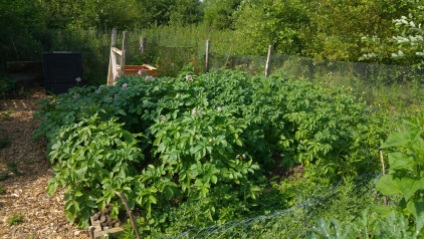



































































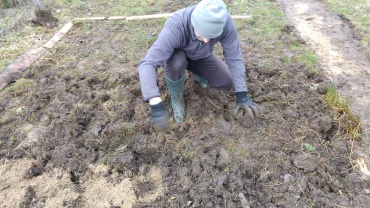

















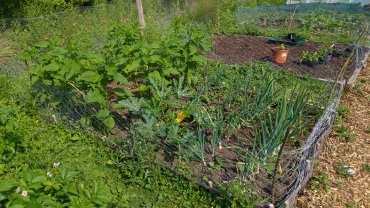


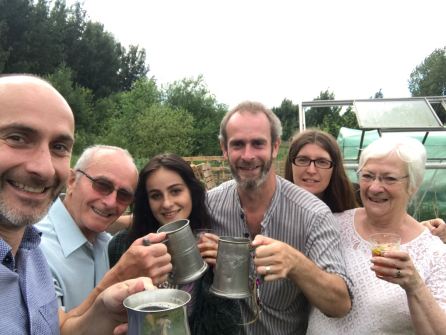







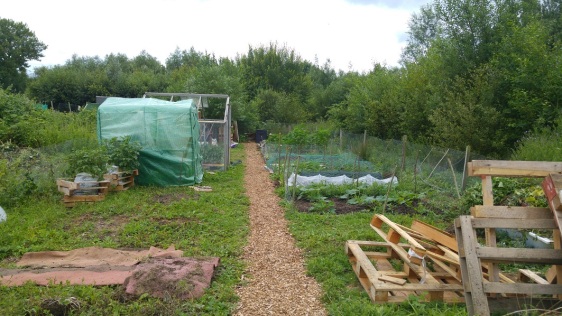





























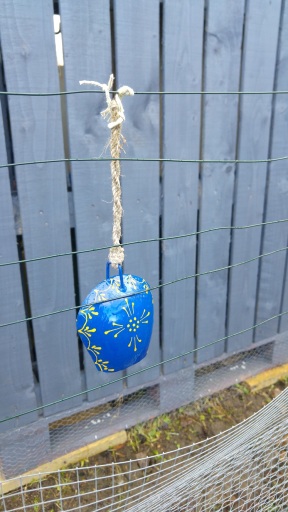






You guys have done so well, your plot looks amazing! I hope you find a balance with the rabbits!
LikeLiked by 1 person
Thank you. 🙂
LikeLike
Well done for persevering! I’ve been battling many slugs and snails in my garden for years but having only recently become involved in an allotment, rabbits are new to me. Looking forward to the challenge and learning from others.
LikeLiked by 1 person
Thank you. I’ve noticed how useful chicken wire has been for keeping snails out. We used the type with tiny holes to stop the rabbits nibbling through it, but it also stops snail shells from passing through. I do have to keep freeing the trapped ones and relocating them elsewhere, though! Rabbits are a whole new kettle of fish – if you ever find anything that works, please let me know!
LikeLiked by 1 person
So much progress! Rabbits can easily jump over a 3′ fence, and I’ve watched them hop up on a bench, low table, tree stump, etc. to get extra height to jump over a 4′ one! Bird netting over crops keeps them safe, but not from mice! I’ve never seen so much mouse damage…all those sprouts!!! I’d invest in some traps and relocate them. Happy I am to see that you are still filled with enthusiasm after such a trying beginning. Best of luck this season!
LikeLiked by 2 people
Thank you, thank you, thank you! You know sometimes when you cannot see the wood for the trees? I think we’ve been suffering a little lately from that and your comment made me look at our plot with fresh eyes – and our neighbour’s plot. They have a tree stump beside our fence, perfect for rabbits to use as a springboard, and it didn’t even twig with me until I read your comment. We’re going to have to raise the fence level again. People have tried trapping the rabbits, but there’s just too many – they even chew their way through bird netting. Still, It’s all part of the adventure of growing on our site!
LikeLiked by 1 person
It’s fun to see all the progress you’ve made in just a year. Lots of hard work, and very impressive results – your garden looks beautiful!
I thought we had critter problems here, but wow, we don’t have anything as bad as what you’re dealing with. I hope you’re able to find solutions.
LikeLiked by 1 person
Thank you. 🙂 Yes, we’re completely overrun but it gives me something to write about! I fear I could get a little repetative, though.
LikeLiked by 1 person
Awesome going! So much in so little time. May you have mant more years at the allotment ahead of you 🙂
LikeLiked by 1 person
Thank you. 🙂
LikeLike
What a great post, made me excited and tired for you at the same time. I am looking to your garden this year. Love all the pictures. xxkat
LikeLiked by 2 people